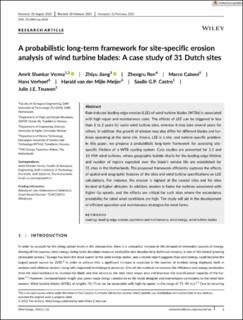A probabilistic long-term framework for site-specific erosionanalysis of wind turbine blades: A case study of 31 Dutch sites
Verma, Amrit; Jiang, Zhiyu; Ren, Zhengru; Caboni, Marco; Verhoef, Hans; Mijle-Meijer, Harald; Castro, Saullo GP; Teuwen, Julie JE
Peer reviewed, Journal article
Published version

Åpne
Permanent lenke
https://hdl.handle.net/11250/2760375Utgivelsesdato
2021Metadata
Vis full innførselSamlinger
Originalversjon
Verma, A., Jiang, Z., Ren, Z., Caboni, M., Verhoef, H., Mijle-Meijer, H., Castro, S. G. & Teuwen, J. J. (2021). A probabilistic long-term framework for site-specific erosionanalysis of wind turbine blades: A case study of 31 Dutch sites. https://doi.org/10.1002/we.2634Sammendrag
Rain-induced leading-edge erosion (LEE) of wind turbine blades (WTBs) is associated with high repair and maintenance costs. The effects of LEE can be triggered in less than 1 to 2 years for some wind turbine sites, whereas it may take several years for others. In addition, the growth of erosion may also differ for different blades and turbines operating at the same site. Hence, LEE is a site- and turbine-specific problem. In this paper, we propose a probabilistic long-term framework for assessing site-specific lifetime of a WTB coating system. Case studies are presented for 1.5 and 10 MW wind turbines, where geographic bubble charts for the leading-edge lifetime and number of repairs expected over the blade's service life are established for 31 sites in the Netherlands. The proposed framework efficiently captures the effects of spatial and orographic features of the sites and wind turbine specifications on LEE calculations. For instance, the erosion is highest at the coastal sites and for sites located at higher altitudes. In addition, erosion is faster for turbines associated with higher tip speeds, and the effects are critical for such sites where the exceedance probability for rated wind conditions are high. The study will aid in the development of efficient operation and maintenance strategies for wind farms.
